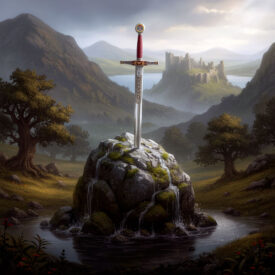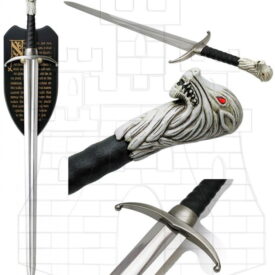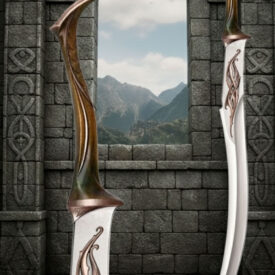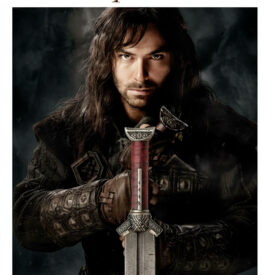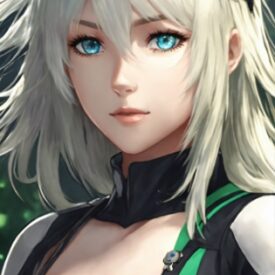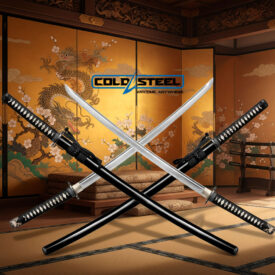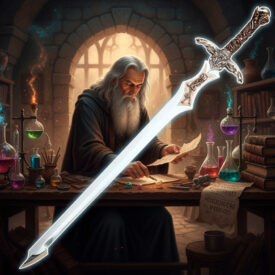What makes Thorin’s sword —Orcrist— so special? Imagine a blade forged in the ancient light of Gondolin, shining with a cold blue glow when orcs approach, and which, centuries later, becomes the emblem of a determined dwarf leader set to reclaim his kingdom. In this article, you will find the history, the forging, the magical properties, a timeline of key events, differences between text and adaptations, technical comparisons with other elven blades, and a practical guide to identify replicas and preserve a sword like Orcrist. All this with the epic and didactic tone that a legendary piece demands.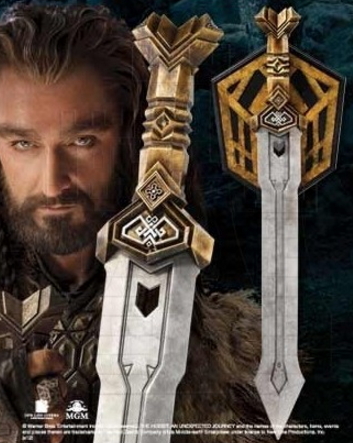
Origin, name, and meaning
Orcrist is not just a sword; it is an inheritance from the First Age. The elves of Gondolin forged weapons of extraordinary beauty and effectiveness, and Orcrist belongs to that lineage. Its name in Sindarin means “Orc-cleaver”, and among those who knew it, it also earned the nickname “Biter” for its lethality against goblins and orcs.
The Tolkienian tradition endows elven weapons with distinguishing features: lightness in hand, a persistent edge, and, on occasion, a magical seal. Orcrist offers all this and adds a virtue: it warns its wielder with a bluish glow when orcs are near. This characteristic makes it a tactical tool and a symbol of protection for whoever wields it.
The blade in Thorin’s story
Thorin II Oakenshield finds Orcrist at the beginning of the quest to reclaim Erebor. After the episode with the trolls and their rescue, the company recovers elven weapons among their belongings; Orcrist passes into Thorin’s hands and becomes integrated into his identity as a leader.
During the journey to the Lonely Mountain, Orcrist accompanies Thorin in decisive battles: in the Misty Mountains against goblins, in skirmishes against orcs, and in the defense of the company. Beyond its practical function, the sword symbolizes lineage, legitimacy, and the connection to a forging tradition that the dwarves respect, even if they are not its creators.
Milestones in the weapons associated with Thorin Oakenshield
Below is a clear timeline of the main milestones related to the weapons that mark the life of Thorin and his family. This section helps you place Orcrist in time within the narrative of Middle-earth.
| Era | Event |
|---|---|
| Third Age of the Sun | |
| 2793–2799 T. A. | Battle of Azanulbizar: Thorin, then young, actively participates. His shield breaks; he cuts an oak branch with his axe and uses it to block blows or as a club, earning him the nickname Oakenshield. |
| 2941 T. A. — Start of the Company’s Mission | Thorin’s company (with Bilbo and Gandalf) is captured by trolls. After the rescue, in the trolls’ cave, Thorin finds the elven blade Orcrist. |
| 2941 T. A. — Tunnels under the Misty Mountains | Thorin uses Orcrist to fight the goblins in the tunnels under the Misty Mountains during the same journey. |
| 2941 T. A. — Battle of the Five Armies | Thorin is mortally wounded in battle. Although the narrative highlights his valor in combat (using his axe), his trusty sword Orcrist is buried with him deep within the Lonely Mountain; the blade would glow at the proximity of orcs as a warning. |
| Film adaptations and replicas | |
| Origin / Dwarven tradition | Thror’s royal sword: this is the weapon associated with King Thror of Erebor. In tradition and adaptations, this sword represents dwarven royalty and is part of the royal house’s heritage. |
| Inheritance (family chronology) | Thror’s royal sword is inherited by his grandson, Thorin Oakenshield, becoming part of his symbolic equipment. |
| Movies — The Hobbit: The Battle of the Five Armies | In Peter Jackson’s cinematic adaptations, Thorin wields Thror’s royal sword during the Battle of the Five Armies. Replicas inspired by that cinematic design were commercialized. |
Forging, provenance, and technical characteristics
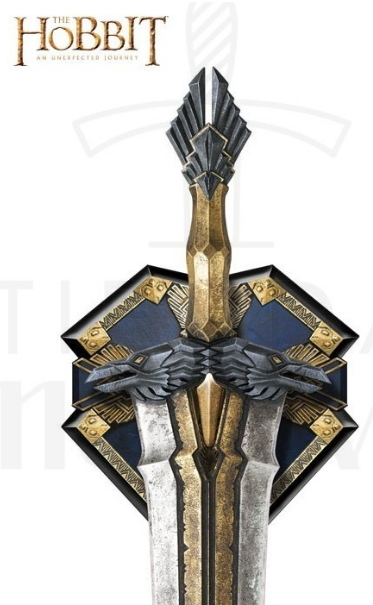 Forged in Gondolin during the First Age, Orcrist is a product of elven techniques that combined forging and aesthetics. Elven blades show a balance between blade curvature and straightness, runic ornamentations, and a temper that maintains the edge despite prolonged use.
Forged in Gondolin during the First Age, Orcrist is a product of elven techniques that combined forging and aesthetics. Elven blades show a balance between blade curvature and straightness, runic ornamentations, and a temper that maintains the edge despite prolonged use.
Technically, these are the characteristics that define Orcrist:
- Material and temper: in mythology, elven steel of extraordinary quality, with a durable edge.
- Design: elegant blade, slightly curved in the middle section, effective for both cutting and thrusting.
- Decoration: runic engravings and elegant motifs denoting royal and ritual origin.
- Magical property: blue glow that detects the presence of orcs and goblins, a characteristic shared with other Gondolin blades such as Glamdring and Sting.
Orcrist in the narrative: symbol and tool
Orcrist acts in the story on two levels: practical and symbolic. In battle, it protects and facilitates enemy detection; outside of combat, it becomes a sign of authority. For Thorin, carrying Orcrist was part of showing himself as the legitimate heir of the house of Durin, a presence that inspires fear among enemies and respect among allies.
Comparison: Orcrist vs Glamdring vs Sting
Understanding the differences between these three blades helps both enthusiasts and collectors to evaluate replicas and their imagined functionality.
| Type | Emblematic User | Origin | Magical Property |
|---|---|---|---|
| Orcrist | Thorin II Oakenshield | Gondolin (First Age) | Glows in the presence of orcs, exceptional edge |
| Glamdring | Gandalf | Gondolin (First Age) | Glows before orcs and trolls, veteran combat blade |
| Sting | Bilbo and Frodo Baggins | Elven forge, found in the trolls’ cave | Glows before orcs, smaller size adapted to hobbits |
- Orcrist
-
- User: Thorin II
- Origin: Gondolin
- Properties: Blue glow before orcs; hard edge.
- Glamdring
-
- User: Gandalf
- Origin: Gondolin
- Properties: Glows in the presence of orcs and trolls; long combat tradition.
- Sting
-
- User: Bilbo, Frodo
- Origin: Elven Blade found with the trolls
- Properties: Glows before orcs; size adapted for a hobbit.
Thorin’s Sword in text vs cinematic adaptations
Tolkien’s prose describes Orcrist with respect and a certain mystery; it does not strive to give exact measurements or concrete ornaments, leaving room for imagination. In contrast, Peter Jackson’s films materialize the sword: they give it a specific design, a crafted hilt, and proportions adapted to Thorin’s figure as he appears on screen. This visual concretization has influenced commercial replicas.
Practical consequence: you will find replicas that follow the cinematic interpretation and others that seek a more faithful reading of the text (slimmer blade, less ornate decoration). Knowing how to distinguish both visions is key if you seek authenticity or fidelity to the film.
Replicas and collectibles available
If you are interested in seeing how legend translates into tangible objects, there are replicas inspired by both the text and the films. Some reproduce the bluish glow with luminescent finishes, and others prioritize the detailed cinematic design. Before evaluating a replica, consider the materials, manufacturing method, and the type of use you will give it (display, reenactment, or study).
How to identify a faithful replica
If you are a collector or simply fascinated by aesthetics, these criteria will help you distinguish a quality replica:
- Blade material: good quality stainless steel or carbon steels with visible temper.
- Finish: a uniform polish, absence of bubbles or visible resins in ornamentation.
- Handle and guard: ergonomics and solid adjustments; in premium replicas, the hilt wrapping and finishes are handcrafted.
- Proportions: verify total length and weight compared to the reference you pursue (film vs text).
- Engravings and details: the presence of well-defined and finished runes indicates care in manufacturing.
Care and maintenance for your Orcrist sword (replica)
A well-preserved replica is a replica that lasts generations. Respect these basic steps:
- Regular cleaning: clean the blade with a dry cloth to remove dust and fingerprints; use special oils for protection if the blade is carbon steel.
- Avoid humidity: storing the sword in dry places with humidity control prolongs its life.
- Handle care: treatments with waxes or natural oils depending on the hilt material.
- Safe display: install supports that do not deform the hilt or scratch the edge; avoid direct and prolonged sun exposure.
Comparative table: materials and usual uses in replicas
| Replica Type | Blade Material | Recommended Use | Maintenance |
|---|---|---|---|
| Decorative (resin/washed steel) | Polyresin or steel with aged finish | Display, cosplay | Minimum: dust and avoid humidity |
| Display (stainless steel) | Stainless steel 440/420 | Premium display, collection | Occasional cleaning and oiling |
| Practical (carbon steel) | Tempered carbon steel | Limited historical reenactment | Intensive maintenance: oil and humidity control |
- Decorative
-
- Material: Resin or washed steel
- Use: Cosplay and decoration
- Maintenance: Basic
- Display
-
- Material: Stainless steel
- Use: Vitrine collections
- Maintenance: Occasional with oils
- Practical
-
- Material: Carbon steel
- Use: Reenactment and controlled cuts
- Maintenance: Frequent and careful
Identity, symbolism, and legacy
For Tolkien’s mythology, weapons are extensions of their wielder’s character. Orcrist embodies Thorin’s pride and warrior nobility; its glow before orcs is, in narrative, a manifestation of the alliance between elven craftsmanship and resistance against dark forces. When Orcrist is buried with Thorin at the end of the Battle of the Five Armies, the sword passes from being an instrument of battle to a funerary object that honors his legacy.
Tips for collectors
- Define your objective: are you looking for fidelity to the novel or to the cinematic design? This delimits which replicas make sense for you.
- Documentation: request technical specifications and high-resolution photographs before confirming a purchase or exchange.
- Authenticity: look for license seals on official replicas or craftsmanship certifications on handmade pieces.
- Conservation: invest in adequate storage and humidity protection if your collection is extensive.
Resolve your doubts about Orcrist and elven swords
What is the story behind Orcrist’s forging?
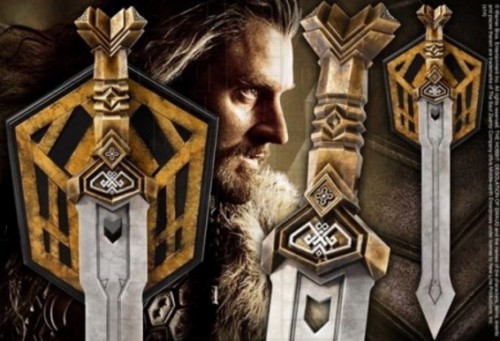 The story behind Orcrist’s forging states that it was created in the legendary elven city of Gondolin during the First Age. This elven sword combines beauty, efficiency, and magic, standing out for its design with curves and a straight edge, as well as its runic engravings. It was forged especially for combat against orcs and goblins and possesses the magical ability to glow with a cold blue light in the presence of these enemies, serving as an alert. Orcrist is also known as “The Orc-Cleaver” and was used centuries later by Thorin Oakenshield in his adventure in The Hobbit, representing a symbol of honor and lineage. Its name comes from Sindarin and means “Orc-Cutter.”
The story behind Orcrist’s forging states that it was created in the legendary elven city of Gondolin during the First Age. This elven sword combines beauty, efficiency, and magic, standing out for its design with curves and a straight edge, as well as its runic engravings. It was forged especially for combat against orcs and goblins and possesses the magical ability to glow with a cold blue light in the presence of these enemies, serving as an alert. Orcrist is also known as “The Orc-Cleaver” and was used centuries later by Thorin Oakenshield in his adventure in The Hobbit, representing a symbol of honor and lineage. Its name comes from Sindarin and means “Orc-Cutter.”
What other elven swords have magical properties similar to Orcrist?
Other elven swords with magical properties similar to Orcrist include Glamdring and Sting. Like Orcrist, these swords were forged by the elves of Gondolin and possess the ability to glow with a blue radiance when orcs are near, making them especially effective against enemies like orcs and goblins. Glamdring was used by Gandalf, while Sting was wielded by Bilbo Baggins. All of them are legendary, with remarkable lightness, durability, and special power in combat against evil.
How did Orcrist influence Thorin’s campaign to reclaim Erebor?
Orcrist influenced Thorin’s campaign to reclaim Erebor primarily as a powerful symbol and an effective weapon against the goblins. Thorin found Orcrist in the trolls’ caves at the beginning of the adventure, recognizing its quality and value as an elven sword. It was a weapon that instilled fear in the goblins, as they recognized and feared it, which favored the battles in the Misty Mountains where Thorin and his company were attacked. Thorin used Orcrist with honor as a symbol of power and unity between dwarves and elves during the expedition.
Although Orcrist did not directly change the strategic plan to reclaim Erebor —which was based on infiltrating through the secret door to access the treasure chamber and confront Smaug— its presence was key in defending against goblin forces and in boosting the morale of Thorin and his companions.
What does Orcrist symbolize in the context of the fight against orcs?
Orcrist symbolizes an elite and feared weapon against orcs, known as “goblin-cleaver” or “orc-splitter,” which glows in the presence of orcs and represents resistance and strength in the fight against them. It was forged by the elves and is associated with the skill and power to defeat these evil creatures. Furthermore, its glow warns its wielder of the proximity of orc enemies, reinforcing its symbolic role as defense and a direct threat to orcs in Middle-earth. Thus, Orcrist is not just a physical weapon but a symbol of struggle and protection against orcs.
What other characters in Middle-earth used swords with magical properties?
Other characters in Middle-earth who used swords with magical properties include:
- Gandalf, who carried the sword Glamdring, an ancient and magical blade forged in Gondolin that glows in the presence of orcs and trolls.
- Bilbo and Frodo Baggins, who used the sword Sting, an elven sword that also glows when detecting the proximity of orcs.
- Aragorn, who wielded the legendary sword Narsil, renewed as Andúril, which symbolized his right to the throne and possessed special power associated with his lineage.
- Túrin Turambar, who used the magical sword Gurthang, forged in Gondolin and capable of speaking and possessing extraordinary power.
- Fingolfin, whose king used the sword Ringil, famous for piercing Morgoth’s armor and overflowing with its own light in combat.
Additionally, swords like Orcrist, carried by Thorin Oakenshield, are also elven weapons with magical capabilities to wound orcs and trolls. These weapons, in general, share the trait of glowing in the presence of dark enemies and are often linked to ancient lineages or elven forging arts with supernatural power.
Legacy and cultural value
Orcrist transcends the page and the screen: it has become a subject of study, replica, and admiration among fantasy enthusiasts. Its story exemplifies how a fictional object can acquire symbolic meaning both within its world and outside, in popular culture, collecting, and modern craftsmanship.
VIEW OFFICIAL HOBBIT AND LORD OF THE RINGS SWORDS | VIEW MORE OFFICIAL HOBBIT PRODUCTS
